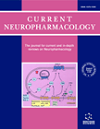- Home
- A-Z Publications
- Current Neuropharmacology
- Previous Issues
- Volume 13, Issue 1, 2015
Current Neuropharmacology - Volume 13, Issue 1, 2015
Volume 13, Issue 1, 2015
-
-
Smart Drugs and Synthetic Androgens for Cognitive and Physical Enhancement: Revolving Doors of Cosmetic Neurology
More LessCognitive enhancement can be defined as the use of drugs and/or other means with the aim to improve the cognitive functions of healthy subjects in particular memory, attention, creativity and intelligence in the absence of any medical indication. Currently, it represents one of the most debated topics in the neuroscience community. Human beings always wanted to use substances to improve their cognitive functions, fro Read More
-
-
-
Synthetic Cathinones: A New Public Health Problem
More LessAuthors: Laurent Karila, Bruno Megarbane, Olivier Cottencin and Michel LejoyeuxNew psychoactive substances (NPS) have completely modified the drug scene and the current landscape of addiction. Synthetic substances, such as substituted or synthetic cathinones, also known as « legal highs », are often produced and used to mimic the effects of controlled drugs such as cocaine, methylenedioxymethamphetamine (MDMA, ecstasy), and methamphetamine. The overwhelming majority of synthetic cathinon Read More
-
-
-
Cathinone Neurotoxicity (“The “3Ms”)
More LessSynthetic cathinones are designer drugs of the phenethylamine class, structurally and pharmacologically similar to amphetamine, 3,4-methylenedioxymethamphetamine (MDMA), cathinone and other related substances. New analogues, legal at least, until formally banned (a time consuming process), are introduced almost daily The United Nations estimates nearly 250 new drug analogues are produced per year. V Read More
-
-
-
Recreational Use, Analysis and Toxicity of Tryptamines
More LessThe definition New psychoactive substances (NPS) refers to emerging drugs whose chemical structures are similar to other psychoactive compounds but not identical, representing a “legal” alternative to internationally controlled drugs. There are many categories of NPS, such as synthetic cannabinoids, synthetic cathinones, phenylethylamines, piperazines, ketamine derivatives and tryptamines. Tryptamines are n Read More
-
-
-
GHB Pharmacology and Toxicology: Acute Intoxication, Concentrations in Blood and Urine in Forensic Cases and Treatment of the Withdrawal Syndrome
More LessAuthors: Francesco P. Busardo and Alan W. JonesThe illicit recreational drug of abuse, γ-hydroxybutyrate (GHB) is a potent central nervous system depressant and is often encountered during forensic investigations of living and deceased persons. The sodium salt of GHB is registered as a therapeutic agent (Xyrem®), approved in some countries for the treatment of narcolepsy-associated cataplexy and (Alcover®) is an adjuvant medication for detoxification and withdra Read More
-
-
-
Caffeine: Cognitive and Physical Performance Enhancer or Psychoactive Drug?
More LessAuthors: Simone Cappelletti, Piacentino Daria, Gabriele Sani and Mariarosaria AromatarioCaffeine use is increasing worldwide. The underlying motivations are mainly concentration and memory enhancement and physical performance improvement. Coffee and caffeine-containing products affect the cardiovascular system, with their positive inotropic and chronotropic effects, and the central nervous system, with their locomotor activity stimulation and anxiogenic-like effects. Thus, it is of interest to examine whethe Read More
-
-
-
Synthetic Androgens as Designer Supplements
More LessAuthors: Jan Felix Joseph and Maria Kristina ParrAnabolic androgenic steroids (AAS) are some of the most common performance enhancing drugs (PED) among society. Despite the broad spectrum of adverse effects and legal consequences, AAS are illicitly marketed and distributed in many countries. To circumvent existing laws, the chemical structure of AAS is modified and these designer steroids are sold as nutritional supplements mainly over the Internet. Several s Read More
-
-
-
Anabolic-androgenic Steroid use and Psychopathology in Athletes. A Systematic Review
More LessThe use of anabolic-androgenic steroids (AASs) by professional and recreational athletes is increasing worldwide. The underlying motivations are mainly performance enhancement and body image improvement. AAS abuse and dependence, which are specifically classified and coded by the DSM-5, are not uncommon. AAS-using athletes are frequently present with psychiatric symptoms and disorders, mainly somatoform and Read More
-
-
-
The Impact of Nandrolone Decanoate on the Central Nervous System
More LessNandrolone is included in the class II of anabolic androgenic steroids (AAS) which is composed of 19-nor-testosterone-derivates. In general, AAS is a broad and rapidly increasing group of synthetic androgens used both clinically and illicitly. AAS in general and nandrolone decanoate (ND) in particular have been associated with several behavioral disorders. The purpose of this review is to summarize the literature concerning Read More
-
-
-
Neurotoxicity by Synthetic Androgen Steroids: Oxidative Stress, Apoptosis, and Neuropathology: A Review
More LessAnabolic-androgenic steroids (AAS) are synthetic substances derived from testosterone that are largely employed due to their trophic effect on muscle tissue of athletes at all levels. Since a great number of organs and systems are a target of AAS, their adverse effects are primarily on the following systems: reproductive, hepatic, musculoskeletal, endocrine, renal, immunological, infectious, cardiovascular, cerebrovascular, Read More
-
-
-
Anabolic Androgenic Steroid (AAS) Related Deaths: Autoptic, Histopathological and Toxicological Findings
More LessAnabolic androgenic steroids (AASs) represent a large group of synthetic derivatives of testosterone, produced to maximize anabolic effects and minimize the androgenic ones. AAS can be administered orally, parenterally by intramuscular injection and transdermally. Androgens act by binding to the nuclear androgen receptor (AR) in the cytoplasm and then translocate into the nucleus. This binding results in sequential conform Read More
-
Volumes & issues
-
Volume 23 (2025)
-
Volume 22 (2024)
-
Volume 21 (2023)
-
Volume 20 (2022)
-
Volume 19 (2021)
-
Volume 18 (2020)
-
Volume 17 (2019)
-
Volume 16 (2018)
-
Volume 15 (2017)
-
Volume 14 (2016)
-
Volume 13 (2015)
-
Volume 12 (2014)
-
Volume 11 (2013)
-
Volume 10 (2012)
-
Volume 9 (2011)
-
Volume 8 (2010)
-
Volume 7 (2009)
-
Volume 6 (2008)
-
Volume 5 (2007)
-
Volume 4 (2006)
-
Volume 3 (2005)
-
Volume 2 (2004)
-
Volume 1 (2003)
Most Read This Month
Article
content/journals/cn
Journal
10
5
false
en


